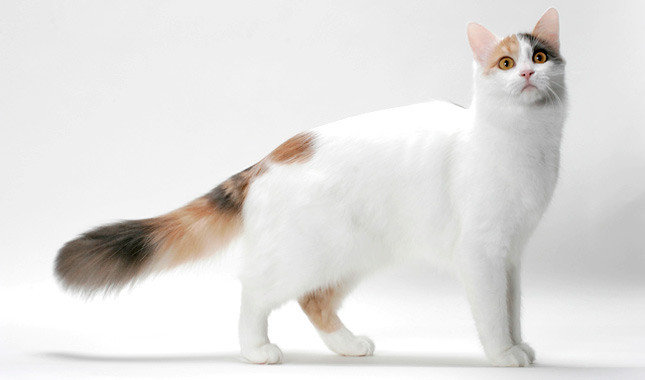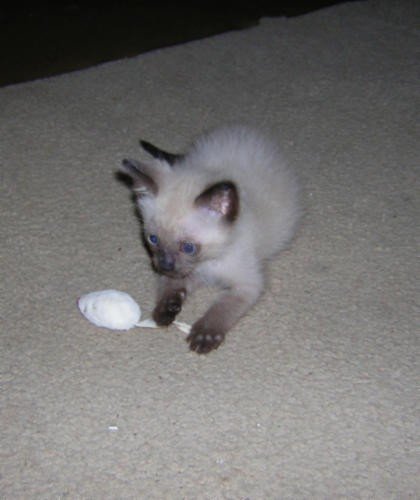My cat i belive he's 1 year old or less but he's full grown. He was all gray as a little kitten but now he has white on him. His mother looks like a purebred rag doll but I know she's not cause her mom looked like a purebred tuxedo, neither the mom or her mom where purebred thou cause my cats live outside. His father looks like kind of a rag doll longhair mix of some kind,the mother of my cats mom's brother looked like my cats brother except short-haired, so I'm thinking maybe longhair/shorthair rag doll & tuxedo mix??What do u think my cat is?
-
Too many ads? Join our community of cat lovers now to reduce ads by 90%! Click here to join for free!
What breed is my kitty?
- Thread starter melican
- Start Date
- Thread Starter Thread Starter
- #2
Can you post a picture?
Sounds bewildering. If it were really important I presume its possible to figure that out by painting it up.
Anyways, both the point gene and the longhair gene behaves similarly. They are recessive, and if the cat carries just one point (or longhair) gen, it doesnt show on the indiviidual. He may be a purebred russian blue. (they used some blue pointed siameses in the breeding programme way back 70 years ago).
He may be a black and white tuxedo, alike the mom here.
So the momma meets another carrier of the point gene, and voilá! In the litter of kittens, one of them is a point, the others looks alike parents. (high probability they have black and white pattern).
If momma meets a real point, whom have is doubled point gene, half of the kittens will be points, the other half will look probably alike momma. Although, if the father is a tabby or lynx, they may also be tabbies or lynx points. As the tabby gene is strong, its enough with just one tabby gene to show. Also white spot gene is strong.
I think black is dominant too, although weaker than both tabby and white spots. Although black can combine with these even when it doesnt become an all black cat.
And its similiar with the longhair gene. "You need two to dance tango", as the saying tells.
Knowing this, you can probably sort out the most probable variations.
Anyways, both the point gene and the longhair gene behaves similarly. They are recessive, and if the cat carries just one point (or longhair) gen, it doesnt show on the indiviidual. He may be a purebred russian blue. (they used some blue pointed siameses in the breeding programme way back 70 years ago).
He may be a black and white tuxedo, alike the mom here.
So the momma meets another carrier of the point gene, and voilá! In the litter of kittens, one of them is a point, the others looks alike parents. (high probability they have black and white pattern).
If momma meets a real point, whom have is doubled point gene, half of the kittens will be points, the other half will look probably alike momma. Although, if the father is a tabby or lynx, they may also be tabbies or lynx points. As the tabby gene is strong, its enough with just one tabby gene to show. Also white spot gene is strong.
I think black is dominant too, although weaker than both tabby and white spots. Although black can combine with these even when it doesnt become an all black cat.
And its similiar with the longhair gene. "You need two to dance tango", as the saying tells.
Knowing this, you can probably sort out the most probable variations.

Tuxedo is a coat pattern, not a particular breed. It's frequently seen in Domestic "___"hair cats. The technical name for it is "bicolor". This pattern can show up in almost any color plus white... red (ginger) and white, black and white, gray and white, tabby and white... but the "classic" tuxedo cat is usually black and white. When the white is limited to the face, paws, throat and chest of an otherwise black cat, they are known in the United States as a tuxedo cat. However, the tuxedo style pattern can occur with other colors besides black.
Cats that are mostly white with some splotches of color on the head and tail, and a maybe little on the limbs, like this pretty tortie-and-white girl, are called "van", and this particular cat is called a Turkish Van. It's from this breed that we get the term "van pattern".
There are many patterns between tuxedo (low-end bicoloring), such as "cap-and-saddle", "mask-and-mantle" and "magpie" (more randomly splashed). Bicolors are found in many breeds, as well as being common in domestic longhair cats and domestic shorthair cats.
My Skye is a low-order bicolor, gray and white. She is mostly gray, but she has some white on her back feet and a small white locket. She also has near-white belly shading that betrays her half-Birman breed. Her mom was a full bred Birman.
Your kitten sounds like a Domestic "something"hair. A picture would help us to narrow it down, and identify the color pattern as well.
He sounds like a cutie-- we'd love to see some pictures here.

Cats that are mostly white with some splotches of color on the head and tail, and a maybe little on the limbs, like this pretty tortie-and-white girl, are called "van", and this particular cat is called a Turkish Van. It's from this breed that we get the term "van pattern".
There are many patterns between tuxedo (low-end bicoloring), such as "cap-and-saddle", "mask-and-mantle" and "magpie" (more randomly splashed). Bicolors are found in many breeds, as well as being common in domestic longhair cats and domestic shorthair cats.
My Skye is a low-order bicolor, gray and white. She is mostly gray, but she has some white on her back feet and a small white locket. She also has near-white belly shading that betrays her half-Birman breed. Her mom was a full bred Birman.
Your kitten sounds like a Domestic "something"hair. A picture would help us to narrow it down, and identify the color pattern as well.
He sounds like a cutie-- we'd love to see some pictures here.

Here is Schrödinger as an adolescent, before his final coat color came in-- notice the "ghost stripes" or "false tabby" marks in his points. None of this is visible now, except for some faint pencil lines on his cheeks. This is common in young adolescent pointed cats. His points are all fully developed now, and there is none of the leg or tail banding remaining. At this point we weren't sure if he was going to be chocolate or natural (seal) point. He is definitely seal!
4-5 months old:
At 10 months-- see how the tail has colored up more and the legs are darker? There are still some ghost bands, but they're slowly fading
A little older here, but not yet a year. The ghost bars on his legs and face are disappearing, just faintly visible...
About a year old. See how the mask has darkened and only one trace of pencil line remains on the cheek. See how dark that paw is here as compared to his 4-5 month and 10 month pictures? Now, he is almost 11 years old and even that cheek color has filled in to make some shading so there are no noticeable ghost lines left.
Today, he is a warm fawn color with deep dark natural (seal) pints and no obvious remnant of banding. It's so fascinating to look at all of these timeline images of my handsome boy as he grew up! He was a funny-looking kitten, but he sure turned into a good-looking cat. I'm so proud of my Meezer!
But I hope this shows well the interaction of the tabby trait with the point. My theory is that the point expression is considerably stronger than the tabby when BOTH coexist in a form OTHER than the lynx gene. It's complicated... makes my head swim, LOL!









